Grub control with flower power, roguing, caging and aerating
-
Anne-Marie Walker
-
Grubs are the larval stage of beetles, a younger form before metamorphosis to adult stage. Because they feed on roots of grasses and plants, discovering grubs in your garden can be far more distressing than finding a bachelor button in a black-eyed Susan’s bed. Here is how to launch a strong offense.
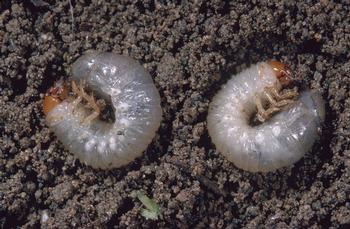 Masked chafer beetle grubs develop underground from the egg that was laid by the scarab beetle above ground. Photo: Jack Kelly, UC State IPM
Masked chafer beetle grubs develop underground from the egg that was laid by the scarab beetle above ground. Photo: Jack Kelly, UC State IPMBeneficial insects are attracted to flowering plants including milkweeds, goldenrod, coneflower, black-eyed Susans, sunflowers, asters, parsley, fennel, dill and mints. One such beneficial is a tiny parasitic wasp that suppresses grubs by laying their eggs into the eggs of beetles preventing metamorphosis into grubs. You are practicing biological control with flower power while creating long-blooming gardens that are a delight to all.
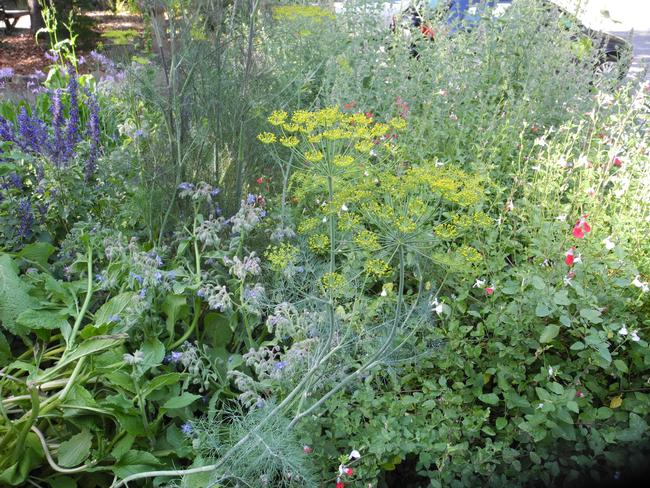 Dill, fennel and anise hyssop, a mint, help attract beneficials to this cottage garden style flower bed. Photo: Anne-Marie WalkerSpecies that undergo complete metamorphosis have different feeding habits during their larval and adult stages. Like other pollinators, adult beetles sip nectar and gather pollen. Beetles lay their eggs at the soil line near plant stems. When the eggs hatch, the larva burrows underground and feeds on roots. Crop damage ensues especially with younger plants of broccoli, cabbage, turnips, radishes, cauliflower and Brussel sprouts. Damage occurs to lawns as well as flowers. An easily recognized insect, some beetles attack nuts, fruits and grains; their hatched eggs are called weevils. In California, the beetles that do the most crop damage include flea beetles, wireworms, cucumber beetles, darkling beetles, vegetable weevils and green fruit beetles. If you grow roses, you are more likely familiar with hoplia beetles, a common rose pest from March through May. They are best controlled by hand picking and disposing in a bucket of soapy water. Once, digging in a raised vegetable bed, I found a large population of white grubs; probably green fruit beetle. Horrified, I dug down and removed the soil until no more grubs were present. Too bad I didn’t just turn the grub-loving chickens loose. If you find grubs in a container in which you grow edibles, remove the plant, discard soil and scrub the container with a solution of 1 part Clorox and 9 parts water before re-planting. If you find grubs in your lawn, they are likely masked chafers, the grub of the scarab beetle. They do major damage to lawns. Check online at UCIPM for guidelines on managing turfgrass grub infestations. You can send pictures of grubs to the Master Gardener Help Desk at HelpDesk@marinmg.org for identification; remember there are more species of beetles than species of plants.
Dill, fennel and anise hyssop, a mint, help attract beneficials to this cottage garden style flower bed. Photo: Anne-Marie WalkerSpecies that undergo complete metamorphosis have different feeding habits during their larval and adult stages. Like other pollinators, adult beetles sip nectar and gather pollen. Beetles lay their eggs at the soil line near plant stems. When the eggs hatch, the larva burrows underground and feeds on roots. Crop damage ensues especially with younger plants of broccoli, cabbage, turnips, radishes, cauliflower and Brussel sprouts. Damage occurs to lawns as well as flowers. An easily recognized insect, some beetles attack nuts, fruits and grains; their hatched eggs are called weevils. In California, the beetles that do the most crop damage include flea beetles, wireworms, cucumber beetles, darkling beetles, vegetable weevils and green fruit beetles. If you grow roses, you are more likely familiar with hoplia beetles, a common rose pest from March through May. They are best controlled by hand picking and disposing in a bucket of soapy water. Once, digging in a raised vegetable bed, I found a large population of white grubs; probably green fruit beetle. Horrified, I dug down and removed the soil until no more grubs were present. Too bad I didn’t just turn the grub-loving chickens loose. If you find grubs in a container in which you grow edibles, remove the plant, discard soil and scrub the container with a solution of 1 part Clorox and 9 parts water before re-planting. If you find grubs in your lawn, they are likely masked chafers, the grub of the scarab beetle. They do major damage to lawns. Check online at UCIPM for guidelines on managing turfgrass grub infestations. You can send pictures of grubs to the Master Gardener Help Desk at HelpDesk@marinmg.org for identification; remember there are more species of beetles than species of plants.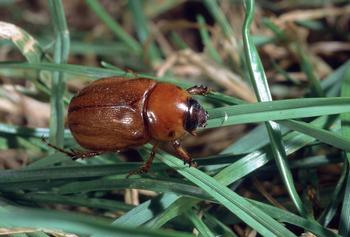 A scarab beetle crawling through grasses. Photo: Jack Kelly, UC Statewide IPMTo build a stronger offense against grubs, augment flower power with roguing, caging and aerating. Roguing is what you do when you go through your garden surveying for diseased plants and remove them right away. It is one of the best tools for disease management in gardens. This is also the time to remove poorly decomposed plant material and all crop residue from the previous season. Caging is a simple technique covering a seed or seedling with a cloche (glass or plastic), wire cage or crop cover like cheesecloth. This prevents beetles from laying their eggs near seedlings. As plants grow, they are better able to defend against beetles. Selecting and planting disease-resistant seedlings further increases a plant’s survival chances. Aerating, especially in the case of lawns, works to distribute water evenly, ensure good drainage and allow deep penetration to the root zone. Since grubs feed close to the surface of the soil, aerating the soil kills significant numbers of grubs. Lastly, good garden cultural practices like adding compost a bit at a time, removing weeds and practicing crop rotation helps combat grubs. Research demonstrates certain plants do attract the natural enemies of insect pests. Be sure to plant those with small flowers accessible to tiny parasitic wasps, our friends who keep our foe the grub at bay. It’s a wonderful web of life out there in our gardens.
A scarab beetle crawling through grasses. Photo: Jack Kelly, UC Statewide IPMTo build a stronger offense against grubs, augment flower power with roguing, caging and aerating. Roguing is what you do when you go through your garden surveying for diseased plants and remove them right away. It is one of the best tools for disease management in gardens. This is also the time to remove poorly decomposed plant material and all crop residue from the previous season. Caging is a simple technique covering a seed or seedling with a cloche (glass or plastic), wire cage or crop cover like cheesecloth. This prevents beetles from laying their eggs near seedlings. As plants grow, they are better able to defend against beetles. Selecting and planting disease-resistant seedlings further increases a plant’s survival chances. Aerating, especially in the case of lawns, works to distribute water evenly, ensure good drainage and allow deep penetration to the root zone. Since grubs feed close to the surface of the soil, aerating the soil kills significant numbers of grubs. Lastly, good garden cultural practices like adding compost a bit at a time, removing weeds and practicing crop rotation helps combat grubs. Research demonstrates certain plants do attract the natural enemies of insect pests. Be sure to plant those with small flowers accessible to tiny parasitic wasps, our friends who keep our foe the grub at bay. It’s a wonderful web of life out there in our gardens.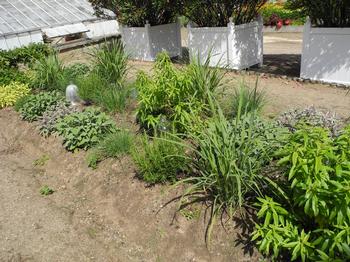 Glass cloches help protect newly planted seedlings from grubs in this herb garden. Photo: Anne-Marie Walker
Glass cloches help protect newly planted seedlings from grubs in this herb garden. Photo: Anne-Marie Walker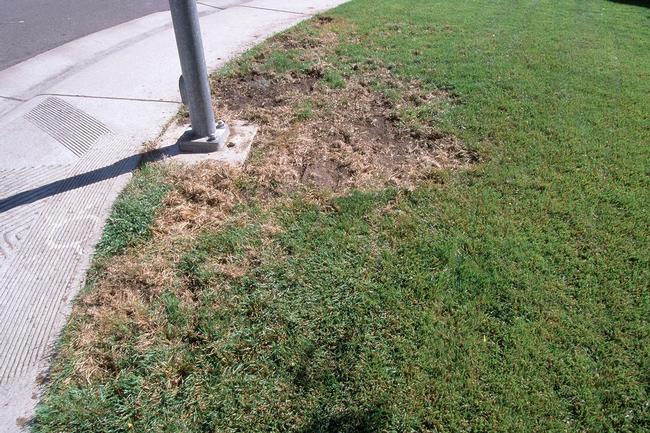 Damage to the lawn was caused by grubs that ate the roots of the grass effectively killing the plant. Photo: Jack Kelly, UC Statewide IPM
Damage to the lawn was caused by grubs that ate the roots of the grass effectively killing the plant. Photo: Jack Kelly, UC Statewide IPM





